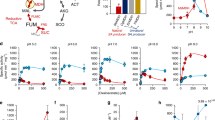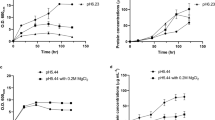Abstract
IN 1948, Korkes and Ochoa1 described an enzyme preparation from Lactobacillus arabinosus which catalysed the conversion of L-malic acid to lactic acid and carbon dioxide. They called it malic enzyme. The activity of this enzyme was found to be very low in organisms grown on ordinary medium. When malic acid was also included in the medium during growth, the ability of the organisms to break down malic acid was found to have increased about fifty times. They also demonstrated that the presence of the growth medium and glucose was essential to the formation of the enzyme.
This is a preview of subscription content, access via your institution
Access options
Subscribe to this journal
Receive 51 print issues and online access
$199.00 per year
only $3.90 per issue
Buy this article
- Purchase on Springer Link
- Instant access to full article PDF
Prices may be subject to local taxes which are calculated during checkout
Similar content being viewed by others
References
Korkes, S., and Ochoa, S., J. Biol. Chem., 176, 463 (1948).
Snell, E. E., J. Bact., 50, 373 (1945).
Gale, E. F., Biochem. J., 34, 392 (1940).
Lichstein, H. C., Ann. Rev. Microbiol., 14, 17 (1960).
Author information
Authors and Affiliations
Rights and permissions
About this article
Cite this article
BOCKS, S. Nutritional Requirements for the Induced Formation of Malic Enzyme in Lactobacillus arabinosus (17–5). Nature 192, 89–90 (1961). https://doi.org/10.1038/192089a0
Issue Date:
DOI: https://doi.org/10.1038/192089a0
This article is cited by
-
�ber die Malat-Dehydrogenase-und Lactat-Dehydrogenase-Aktivit�t L-�pfels�ure-abbauender Bakterien
Archiv f�r Mikrobiologie (1969)
Comments
By submitting a comment you agree to abide by our Terms and Community Guidelines. If you find something abusive or that does not comply with our terms or guidelines please flag it as inappropriate.



